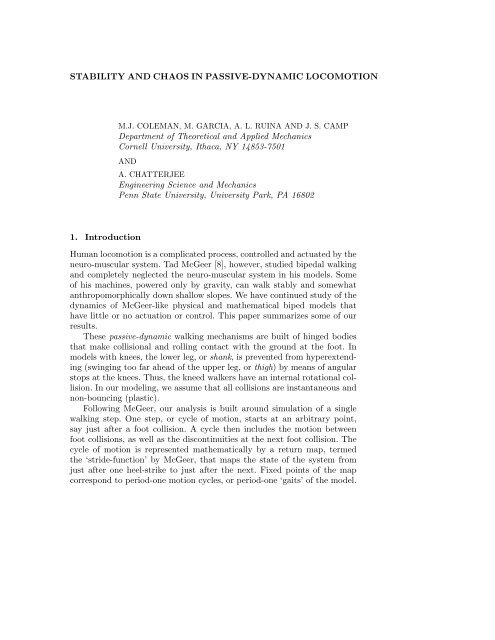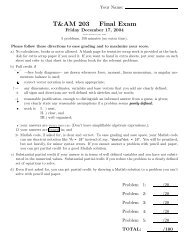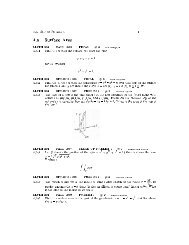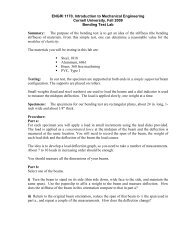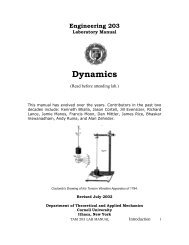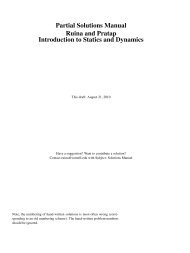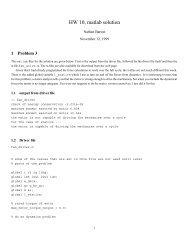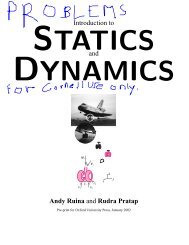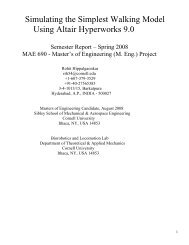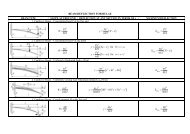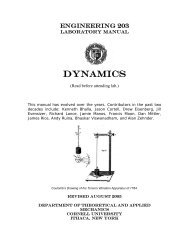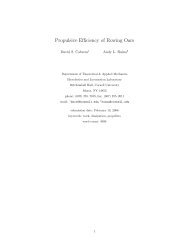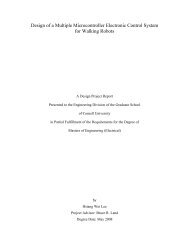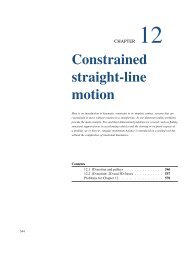STABILITY AND CHAOS IN PASSIVE-DYNAMIC ... - Cornell University
STABILITY AND CHAOS IN PASSIVE-DYNAMIC ... - Cornell University
STABILITY AND CHAOS IN PASSIVE-DYNAMIC ... - Cornell University
You also want an ePaper? Increase the reach of your titles
YUMPU automatically turns print PDFs into web optimized ePapers that Google loves.
<strong>STABILITY</strong> <strong>AND</strong> <strong>CHAOS</strong> <strong>IN</strong> <strong>PASSIVE</strong>-<strong>DYNAMIC</strong> LOCOMOTION<br />
M.J. COLEMAN, M. GARCIA, A. L. RU<strong>IN</strong>A <strong>AND</strong> J. S. CAMP<br />
Department of Theoretical and Applied Mechanics<br />
<strong>Cornell</strong> <strong>University</strong>, Ithaca, NY 14853-7501<br />
<strong>AND</strong><br />
A. CHATTERJEE<br />
Engineering Science and Mechanics<br />
Penn State <strong>University</strong>, <strong>University</strong> Park, PA 16802<br />
1. Introduction<br />
Human locomotion is a complicated process, controlled and actuated by the<br />
neuro-muscular system. Tad McGeer [8], however, studied bipedal walking<br />
and completely neglected the neuro-muscular system in his models. Some<br />
of his machines, powered only by gravity, can walk stably and somewhat<br />
anthropomorphically down shallow slopes. We have continued study of the<br />
dynamics of McGeer-like physical and mathematical biped models that<br />
have little or no actuation or control. This paper summarizes some of our<br />
results.<br />
These passive-dynamic walking mechanisms are built of hinged bodies<br />
that make collisional and rolling contact with the ground at the foot. In<br />
models with knees, the lower leg, or shank, is prevented from hyperextending<br />
(swinging too far ahead of the upper leg, or thigh) by means of angular<br />
stops at the knees. Thus, the kneed walkers have an internal rotational collision.<br />
In our modeling, we assume that all collisions are instantaneous and<br />
non-bouncing (plastic).<br />
Following McGeer, our analysis is built around simulation of a single<br />
walking step. One step, or cycle of motion, starts at an arbitrary point,<br />
say just after a foot collision. A cycle then includes the motion between<br />
foot collisions, as well as the discontinuities at the next foot collision. The<br />
cycle of motion is represented mathematically by a return map, termed<br />
the ‘stride-function’ by McGeer, that maps the state of the system from<br />
just after one heel-strike to just after the next. Fixed points of the map<br />
correspond to period-one motion cycles, or period-one ‘gaits’ of the model.
2 M.J. COLEMAN ET AL.<br />
Gait stability can be determined by calculating (most often numerically)<br />
the eigenvalues of the linearization of the map at the fixed points (see [3]<br />
for a detailed description of the modeling and analysis procedures).<br />
(a)<br />
x<br />
κ<br />
G<br />
r<br />
z<br />
D<br />
crooked<br />
masses; I G , m C<br />
disc; I D , m D<br />
massless fork<br />
y<br />
L<br />
E<br />
(b)<br />
downslope<br />
plane of<br />
wheel<br />
l<br />
m, I C<br />
C<br />
x F<br />
fixed coord.<br />
syst. α<br />
n = number of<br />
spokes<br />
g<br />
β = 2π n<br />
rest<br />
configuration<br />
z F<br />
y F<br />
Figure 1. The parameters and orientation variables for (a) a uniform rolling disk with<br />
oblique masses added and (b) a rimless spoked wheel.<br />
Using this scheme, we have studied several passive-dynamic models of<br />
increasing complexity, progressing from rolling wheels to 2D straight-legged<br />
and kneed models to 3D straight-legged models, each of which is described<br />
below. We also describe a simple barely-controlled powering scheme for a<br />
2D straight-leg walker, which produces stable gait on level ground.<br />
2. Rolling Wheels in 2D and 3D<br />
Perhaps the simplest passive-dynamic system to study, that has some features<br />
in common with walking, is the rimless spoked wheel, or rolling polygon,<br />
confined to 2D [8]. The 2D rimless wheel has a stable limit cycle motion<br />
whose eigenvalues and associated global basins of attraction we have completely<br />
determined analytically [3]. The primary lesson of the rimless wheel<br />
in 2D is that speed regulation comes from a balance of collisional dissipation,<br />
which is proportional to speed squared, and gravitational work, which<br />
is proportional to speed.<br />
Next, we studied a 3D rolling disk with oblique masses added [3] (see<br />
Figure 1). The masses can bank and steer with the disk but cannot roll (or<br />
pitch) with it. The purpose of this investigation was to study the effects<br />
of mass distribution on stability. The oblique masses, if adjusted properly,<br />
change the stability of the uniform rolling disk, a conservative nonholonomic<br />
system, from neutrally stable to asymptotically stable [10]. This result<br />
suggests that mass distribution may affect side-to-side balance in more<br />
complicated walking models.<br />
Finally, we studied the 3D rimless wheel (see Figure 1) and found analytically,<br />
for many spokes and small slope angles, the stability eigenvalues<br />
for steady ‘rolling’ motions [1]. The 3D rimless wheel is a piecewise-
<strong>STABILITY</strong> <strong>AND</strong> <strong>CHAOS</strong> <strong>IN</strong> <strong>PASSIVE</strong>-<strong>DYNAMIC</strong> LOCOMOTION 3<br />
conservative-holonomic (but globally non-conservative and nonholonomic)<br />
system with intermittent, dissipative impacts – features that are shared by<br />
some more realistic human walking models. The rolling rimless wheel can<br />
also exhibit asymptotic stability when perturbed from a downhill limit cycle,<br />
even when its mass distribution corresponds to that of a disk that does<br />
not have asymptotic stability. Thus, the intermittent collisions can play a<br />
role in side-to-side balance.<br />
Despite the useful lessons from rolling models, they are not anthropomorphic<br />
walkers. They cannot fall down forwards or backwards, and they<br />
lack swinging legs.<br />
3. Straight-Legged 2D Walkers<br />
The next-simplest class of models live in 2D and consist of two linked swinging<br />
legs and point-feet [8, 6, 3, 5]. Asymptotically-stable walking motions<br />
of these models exist for a variety of parameters. The simplest such ‘pointfoot’<br />
straight-legged model has a huge hip mass and tiny masses (relatively<br />
infinitesimal) at its point-feet (see Figure 2).<br />
A typical plot of the stance-leg and swing-leg angles is shown over one<br />
stable step in Figure 2. This model exhibits two steady walking motions,<br />
or period-one gaits, all the way to γ → 0 + as shown in Figure 3. At these<br />
gaits, the stance angle (and step length) are proportional to γ 1/3 . Figure 4<br />
shows how stable limping (period-two) and apparently-chaotic ‘staggering’<br />
gaits appear as the slope angle is increased.<br />
That this machine can walk on arbitrarily small slopes means that,<br />
by some reasonable measures, it is capable of near-perfectly-efficient gait<br />
(zero+ energy cost per unit distance of transport). At small slopes, the<br />
gravitational power used by this model in downhill walking is proportional<br />
to the fourth power of the walking speed. This result gives insight into<br />
achieving similar efficiency in more complicated models (e.g. models with<br />
knees, circular feet, and/or more general mass distribution). The power<br />
scaling depends, in part, on the infinitesimally small feet. With finite-mass<br />
feet, there are two modes of energy loss at heelstrike: one due to deflection<br />
of the hip mass, and one due to dissipation of the foot’s kinetic energy in a<br />
plastic collision with the ground. Preliminary studies of point-foot models<br />
with finite foot mass show that the long-period gaits retain the same scaling<br />
laws at small slopes, while the short-period gaits do not.<br />
4. More General 2D Walkers<br />
We have reproduced and extended McGeer’s results for more general 2D<br />
walkers with knees[8]: Figure 5 shows the state variables and parameters for
4 M.J. COLEMAN ET AL.<br />
0.25<br />
0.2<br />
swing leg angle θ sw<br />
γ = 0.009 rad<br />
m
<strong>STABILITY</strong> <strong>AND</strong> <strong>CHAOS</strong> <strong>IN</strong> <strong>PASSIVE</strong>-<strong>DYNAMIC</strong> LOCOMOTION 5<br />
negative stance angle at fixed point, -θ ∗ st , rad<br />
0.3<br />
0.25<br />
0.2<br />
0.15<br />
0.1<br />
0.05<br />
long period<br />
solutions<br />
stable gait solutions,<br />
analytic and numerical<br />
(heavy line)<br />
stable higher-period<br />
solutions (see inset)<br />
stable walking down to zero slope<br />
short period<br />
solutions (always unstable)<br />
analytic approx.<br />
numerical points<br />
0<br />
0 0.005 0.01 0.015 0.02 0.025 0.03 0.035 0.04 0.045<br />
slope γ, rad<br />
x<br />
Figure 3. Comparison of numerical and analytic predictions for point-foot stance angle<br />
at fixed point as a function of slope. The box is shown expanded in Figure 4.<br />
negative stance angleat fixed point -θ ∗ st, rad<br />
0.27<br />
0.26<br />
0.25<br />
0.24<br />
stable period-2 gait<br />
stable<br />
period-1<br />
gait<br />
stable period-4 gait<br />
unstable<br />
period-1 gaits<br />
didn't find stable solutions here<br />
0.014 0.015 0.016 0.017 0.018 0.019 0.02<br />
slope γ , rad<br />
'normal' gait limping gait 4,8,...-step & 'chaos'<br />
Figure 4. Period doubling of stable walking motions, inset from Figure 3. Period doubling<br />
occurs when one of the map eigenvalues for a period-n walking cycle passes through −1.<br />
Unstable period-one cycles are shown for reference. Dotted lines represent stable cycles<br />
while solid lines represent unstable ones. No persistent walking was found at slopes much<br />
steeper than 0.019 radians.<br />
legged Tinkertoy R○ model that walks passively, apparently stably, down<br />
gentle slopes [2] (see Figure 7).
6 M.J. COLEMAN ET AL.<br />
a) DIMENSIONAL PARAMETERS<br />
b) <strong>DYNAMIC</strong> VARIABLES<br />
r T<br />
, m T<br />
r S<br />
, m S<br />
l T cT<br />
g<br />
w S<br />
ε T<br />
R<br />
ε T<br />
w T<br />
c S<br />
ε T<br />
θsh<br />
θth<br />
-θst<br />
γ<br />
l S<br />
ε T<br />
Figure 5. McGeer’s kneed walking model. Shown above are (a) model parameters, and<br />
(b) dynamic variables. Radii of gyration and masses of thigh and shank are denoted by<br />
r T ,m T,r S, and m S, respectively. The foot is a circular arc centered at the “+”. ɛ T is<br />
defined to be the angle between the stance thigh and the line connecting the hip to the<br />
foot center. Dynamic variable values θ st, θ th , and θ sh are measured from ground-normal<br />
to lines offset by ɛ T from their respective segments. A stop (not shown) at each knee<br />
prevents hyperextension of either knee.<br />
The configuration and mass distribution of the legs of the Tinkertoy R○<br />
model were suggested by numerical simulations of a simpler 3D model (see<br />
Figure 8) that was predicted to be almost-stable. The model predicts nearstable<br />
steady 3D walking solutions (the maximum return map eigenvalue<br />
is |σ| max ≈ 1.15 with all others σ ≤ 1) for very low center-of-mass and<br />
lateral center-of-mass location comparable to the leg length. As the lateral<br />
center-of-mass position get very large, the model predicts something like<br />
‘tight-rope’ walking with a long balance bar: the step period and length get<br />
very small, and the maximum map eigenvalue modulus approaches 1 (neutral<br />
stability) asymptotically from above (see Figure 10). More detailed 3D<br />
modeling is currently in progress. This walking mechanism joins a small<br />
list of passive mechanical devices free to move in three dimensions but<br />
without fast spinning parts, that are statically unstable, yet can be dynamically,<br />
asymptotically stable. Figure 9 shows typical 3D periodic behavior<br />
predicted by the model.<br />
6. Powered ‘Passive’ Walking<br />
Once power is added to our passive devices, they are, of course, no longer<br />
uncontrolled in the pure sense. Nevertheless, as shown by McGeer [7], a<br />
stable passive-dynamic model is a good basis for simple ‘open-loop’ powering<br />
schemes. Figure 11 shows the configuration and simulated walking<br />
cycle for a powered 2D point-foot-like model. The torque is provided by a<br />
constant-voltage DC motor at the stance-ankle. The ankle is locked during<br />
the passive mode.
<strong>STABILITY</strong> <strong>AND</strong> <strong>CHAOS</strong> <strong>IN</strong> <strong>PASSIVE</strong>-<strong>DYNAMIC</strong> LOCOMOTION 7<br />
leg angles (rad)<br />
0.5<br />
0.4<br />
0.3<br />
0.2<br />
0.1<br />
0<br />
-0.1<br />
-0.2<br />
-0.3<br />
-0.4<br />
-0.5<br />
θ sh<br />
θ th<br />
heelstrike<br />
heelstrike<br />
θ st<br />
kneestrike<br />
θ sh =θ th<br />
3 3.5 4 4.5 5 5.5<br />
time, [(l S +l T )/g ] 1/2<br />
3 link mode 2 link mode<br />
1 step<br />
Heelstrike 3 Link Mode Kneestrike 2 Link Mode Heelstrike<br />
Simulated single-leg strobe-shots Human data including trunk (from<br />
(A little more than two steps) Winter 1987, used with permission)<br />
γ=0.036<br />
.2 m<br />
.2 m<br />
Figure 6. Simulated gait cycle (ours, similar to McGeer’s). Angles of leg segments are<br />
shown from just before one heelstrike to just after the next heelstrike in a stable gait of<br />
the walker in Figure 5. The heavy line on the graph corresponds to the motion of the<br />
heavy-line leg on the small cartoon under the graph. At the start of the step, this is the<br />
stance leg, but it becomes the swing leg just after the first heelstrike. The strobe-like<br />
picture of the walker on the bottom left, created from the simulated gait cycle in the<br />
graph, shows the anthropomorphic nature of the gait. The stroboscopic picture on the<br />
lower right was generated from experimental data from [11]. The parameters values used,<br />
from a working physical model in our lab, are: l t =0.35m, w t = 0m, m t =2.345kg,<br />
r t =0.099m, c t =0.091m, l s =0.46m, w s =0.025m, m s =1.013kg, r s =0.197m,<br />
c s =0.17m, R =0.2m, γ =0.036rad, g =9.81 m/s 2 , ɛ T =0.097rad.<br />
7. Conclusions<br />
The human-like and complicated motions of McGeer-like passive dynamic<br />
devices studied by ourselves and others imply that coordination in locomotion<br />
may be largely governed by pure mechanics. It has yet to be determined<br />
whether or not these models have medically-useful lessons to teach us, and<br />
whether or not they are a good spring-board for biomechanical or robotic
8 M.J. COLEMAN ET AL.<br />
metal nuts<br />
brass strips<br />
Figure 7. A drawing of our 3D Tinkertoy R○ walking model. The center-of-mass of the<br />
device is above the centers of the wheel-like feet and behind the leg axes. The metal<br />
nuts for weight and the brass strips to round the foot bottoms are fastened with black<br />
electrical tape.<br />
a) Dimensional Parameters<br />
X cm<br />
sw<br />
hinge<br />
joint<br />
plane of walker<br />
Y st<br />
cm<br />
X sw<br />
cm<br />
ball-and-socket<br />
joint<br />
x SW<br />
z ST<br />
z SW<br />
y SW<br />
x ST<br />
Z st<br />
cm<br />
y ST<br />
Y sw<br />
cm<br />
z F<br />
y F<br />
x F<br />
α<br />
l<br />
Z sw<br />
cm<br />
downslope<br />
g<br />
rest<br />
configuration<br />
swing leg<br />
b) Orientation Variables<br />
z ST<br />
θ sw<br />
z SW<br />
θ st<br />
x ST<br />
ψ<br />
φ<br />
y SW<br />
ψ<br />
x SW<br />
rotated<br />
stance frame<br />
configuration<br />
θ st<br />
stance leg<br />
Figure 8. The orientation variables and parameters for the 3D straight-legged point-foot<br />
walking model. Each leg has mass M, moment of inertia matrix I cm , and length l.<br />
y ST<br />
models that incorporate neuro-muscular elements or mechanical actuators.<br />
References<br />
1. M. Coleman, A. Chatterjee, and A. Ruina. Motions of a rimless spoked wheel: A<br />
simple 3D system with impacts. Dynamics and Stability of Systems, 1997. In press.<br />
2. M. Coleman and A. Ruina. A Tinkertoy R○ model that walks. Physical Review<br />
Letters, 1997. accepted for publication.<br />
3. M. J. Coleman. A Stability Study of a Three-dimensional Passive-dynamic Model<br />
of Human Gait. PhD thesis, <strong>Cornell</strong> <strong>University</strong>, Ithaca, NY, 1997. In preparation.<br />
4. J. V. Fowble and A. D. Kuo. Stability and control of passive locomotion in 3-D.
<strong>STABILITY</strong> <strong>AND</strong> <strong>CHAOS</strong> <strong>IN</strong> <strong>PASSIVE</strong>-<strong>DYNAMIC</strong> LOCOMOTION 9<br />
(a) 0.1<br />
leg angles (rad)<br />
0.05<br />
0<br />
-0.05<br />
-0.1<br />
-0.15<br />
stance leg swing leg angle,<br />
angle, θ* st (τ) θ*<br />
sw (τ)+θ * st (τ)-π<br />
-0.2<br />
0 0.2 0.4 0.6 0.8 1 1.2 1.4<br />
τ, non-dimensional time<br />
(b) 2 x 10-3 1 bank<br />
0<br />
-1<br />
-2<br />
heading<br />
heading, φ and bank, ψ<br />
-3<br />
-4<br />
-5<br />
0 0.2 0.4 0.6 0.8 1 1.2 1.4<br />
τ, non-dimensional time<br />
Figure 9. Simple 3-D simulations. Typical periodic gait cycle behavior over two steps<br />
for I xx = 0.5577, I yy = 0.00021, I zz = 0.5579, I xy = 0.0000, I xz = 0.0, I yz = 0.0,<br />
α = 0.0037,x = 0.0, y = 0.2706, and z = 0.9270. The fixed point for this case is<br />
q ∗ = {0.0000 0.000008 − 0.0597 3.2610 − 0.0132 0.00051 0.1866 − 0.8523} T ; the maximum<br />
eigenvalue is |σ max| =2.58 and the non-dimensional step period is τ ∗ =1.2031.<br />
(a) The periodic gait cycle leg angles are very similar to those for 2D walking. The<br />
heavy line on the graph corresponds to the motion of the heavy-lined leg in Figure 8.<br />
At start-of-step, this is the stance leg, but at a foot-collision, it becomes the swing leg.<br />
The instants of foot-strike are denoted by the light gray lines. (b) The plots show the<br />
relationship of the heading and the bank angle of the walker over two steps.<br />
τ*, step period<br />
1.4<br />
1.2<br />
1<br />
0.8<br />
0.6<br />
0.4<br />
0 0.5 1 1.5 2<br />
lateral c.o.m. position<br />
*<br />
-0.04<br />
-0.05<br />
-0.06<br />
-0.07<br />
0 0.5 1 1.5 2<br />
lateral c.o.m. position<br />
θst , stance angle-0.03<br />
|σ| max , max. eigenvalue<br />
3<br />
2.5<br />
2<br />
1.5<br />
1<br />
0 0.5 1 1.5 2<br />
lateral c.o.m. position<br />
Figure 10. Point-foot 3D simulation. The effect of lateral c.o.m. mass position on the<br />
limit cycle period, stance angle, and maximum eigenvalue modulus. Note that the simple<br />
simulation does not predict stability whereas the more complex physical model is stable.<br />
In Biomechanics and Neural Control of Movement, pages 28–29, Mount Sterling,<br />
Ohio, 1996. Engineering Foundation Conferences.<br />
5. M. Garcia, A. Chatterjee, A. Ruina, and M. J. Coleman. The simplest walking<br />
model: Stability, complexity, and scaling. ASME Journal of Biomechanical Engineering,<br />
1997. In press.<br />
6. A. Goswami, B. Thuilot, and B. Espiau. Compass-like biped robot, part I: Stability<br />
and bifurcation of passive gaits. Rapport de recherche 2996, Unité de recherche<br />
<strong>IN</strong>RIA Rhône-Alpes, St. Martin, France, October 1996.<br />
7. T. McGeer. Dynamics and control of bipedal locomotion. Progress in Robotics and<br />
Intelligent Systems, 1990.<br />
8. T. McGeer. Passive dynamic walking. The International Journal of Robotics Research,<br />
9(2):62–82, April 1990.<br />
9. T. McGeer. Passive dynamic catalogue. Technical report, Aurora Flight Sciences<br />
Corporation, 1991.<br />
10. J. Papadopolous. personal communication, 1996.
10 M.J. COLEMAN ET AL.<br />
0.8<br />
0.6<br />
0.4<br />
θ sw<br />
leg angles (rad)<br />
0.2<br />
0<br />
-0.2<br />
-0.4<br />
-0.6<br />
θ st<br />
heelstrike: stance<br />
foot switches<br />
θ stf<br />
θ stf = 0<br />
(foot locked)<br />
θ st<br />
stance foot<br />
begins to extend<br />
θ sw<br />
Heelstrike Passive Mode<br />
-0.8<br />
0 0.5 1 1.5 2 2.5 3 3.5 4 4.5<br />
τ<br />
stance<br />
leg<br />
Q2 lock<br />
swing<br />
leg<br />
g<br />
−θ sw<br />
Mhip<br />
Q2 lock<br />
l<br />
R<br />
θ sw<br />
−θ st<br />
θ st<br />
θ stf<br />
D<br />
M ank<br />
powered,<br />
3 link mode<br />
passive, 2 link mode<br />
1 step<br />
Motor Turns on<br />
Powered Mode<br />
Motor Turns On<br />
Figure 11. The state of the powered 2D walker versus time over one<br />
stable gait cycle. The two inset boxes show the parameters and orientation<br />
variables of the 2D powered walker gait cycle. Parameters are as follows:<br />
M ank =1,M hip = 1000,l =1,R =0,D =0.05,Q2 lock =3π/4, and Q3 switch =2.8625.<br />
DC motor characteristics are ω no−load = 100 and T stall = 725. The actuation begins<br />
when Q3 =Q3 switch , where Q3 =π+θ sw − θ st (the swing leg angle measured from the<br />
projection of the stance leg).<br />
11. D. A. Winter. The Biomechanics and Motor Control of Human Gait. <strong>University</strong> of<br />
Waterloo Press, Waterloo, Ontario, 1987.


